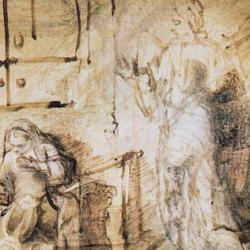It’s not clear how much rethinking Gordon Wenham has done to produce his Rethinking Genesis 1-11. After all, Wenham has been writing illuminating commentary about the early chapters of Genesis for a long time. Re-thought or not, his new little book contains some treasures.
He observes the inversion of Genesis 1:1 (“In the beginning created God the heavens and the earth”) and 2:1-3 (“heavens and earth were finished . . . God finished . . . God rested from all his work . . . in creation). Beyond that, he notes the intricate interlacing of sevens in the opening chapters.
Both Genesis 1:1 and 2:3 are “made up of multiples of seven words. 1:1 has seven words, 1:2 has fourteen (7 x 2) words, while 2:1-3 has thirty-five (7 x 5) words.” Key terms and phrases also occur in multiples of seven in 1:1-2:3: “‘God occurs thirty-five times, ‘earth’ twenty-one times, ‘heaven/firmament’ twenty-one times, ad the phrases “and it was so’ and ‘God saw that it was good’ occur seven times each” (5).
The patterning continues into the following chapters. 2:4 is laid out chiastically (generations of heaven and earth/created/in day God made/earth and heavens). This chiastic arrangement both picks up terminology from 1:1 (God, created, heaven and earth) but anticipates the opening verses of following sections (“generations,” 5:1; 6:9). Even when Genesis uses disjunctive phrases to mark the beginning of a new section, those disjunctions simultaneously knit sections of the text together (20).
Wenham observes the difference in time frame between the original creation and the decreation/recreation that takes place in the flood – six days v. half a year. But the careful chronology of the flood narrative also brings out similarities between the original creation account and the flood. Using the calendar found in the Book of Jubilees as a guide, Wenham argues that “The rain and floods according to this calendar began on Sunday, which is the first day of the week, the first day of creation according to Genesis 1. They continued for forty days till Friday (Gen 7:12). In other words, the destructive phase of the flood began on a Sunday and ended on a Friday, just as the original creation began on a Sunday and ended on Friday, the day before the Sabbath. In this way, de-creation mirrors creation chronologically as well as substantially, but it took a bit longer, forty days instead of six.” He detects Sabbatical patterns throughout the flood narrative, concluding that “God observes the Sabbath and so does righteous Noah” (45).
Throughout the book, Wenham reflects on the parallels between ANE mythology and the Genesis account of creation, flood, and Babel. He is aware of the similarities, but stresses the differences, especially the theological differences in the character and unity of the God of the Bible. There are points to dispute, but in the main this is a useful brief guide to the early chapters of the Bible, from a seasoned, wise, and attentive commentator.















